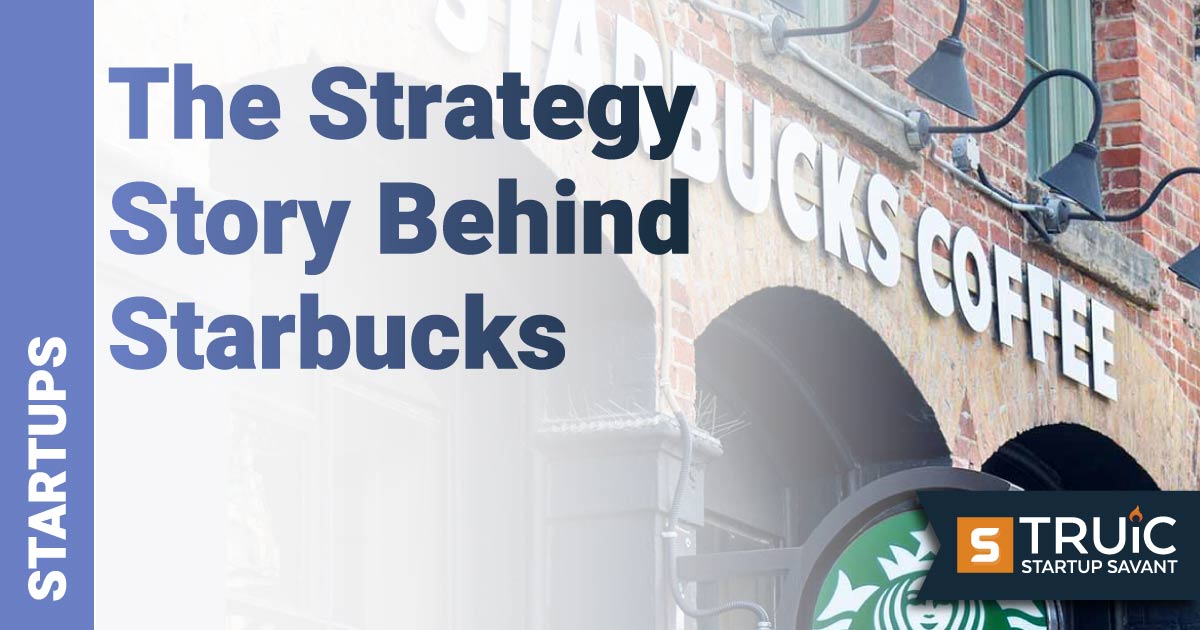The Strategy Story Behind Starbucks

Last Updated: By TRUiC Team
Starbucks is a prime example of how a coffee business can use a well-executed strategy to achieve growth. What started out as a small coffee shop in Seattle has turned into one of the largest coffee chains in the world.
So what is Starbucks' secret? And more importantly, what can startups learn from Starbucks' strategy? Let’s take a look at the key aspects of Starbucks' strategy and how it has helped them achieve such success.
Developing the Starbucks Model
Starbucks’ creation story starts with three college friends in Seattle. Zev Siegel, Jerry Baldwin, and Gordon Bowker all decided to open a coffee shop together in 1973. The first step to developing the Starbucks model was gaining a mentor in Alfred Peete. The Peet's Coffee store was already doing well, and Alfred was one of the most notable and knowledgeable coffee entrepreneurs in the country. Mentors often provide a shortcut to learning the advantages and disadvantages of the industry, and Peet provided plenty of support. He gave them roasted coffee beans and introduced the entrepreneurs to brokers in the industry until they could get their own operation setup.
For the next decade, Starbucks focused on expanding within the Seattle area, opening up five more shops. This feat is even more impressive, considering they didn't even sell actual coffee drinks at this point. Their main focus is on bringing premium beans to customers who were used to canned or instant coffee. It wasn't until Starbucks hired their Director of Marketing and Sales that they would begin to expand beyond their Seattle beginnings.
Caffeinating the World: Starbucks’ Global Impact
When Starbucks' Director of Marketing and Sales Howard Schultz came back from a trip to Italy, he incorporated an idea into the company that would change the industry. Schultz wanted to recreate the small cafes in Italy and suggested turning every Starbucks into a small cafe.
Once the concept was validated, growth and expansion were at the top of the list. Schultz took over the company four years after he had the initial idea, and by the time Starbucks went public, it had over 165 stores.
The year 1996 was huge for the coffee company because it was the first time they were able to expand the business internationally in Japan and Singapore. At that point, the company had 1,000 stores, and just four years later, they had opened over 2,000 locations. This growth would continue from 2000 to 2007 when Starbucks opened over 15,000 stores across the world.
The Crash and Stabilization
In 2007, the financial crash hit the world, and Starbucks saw a huge drop in its stock prices.
Their famous growth was immediately halted, and the company brought back Howard Schultz. Instead of focusing on growing into as many areas as possible, Schultz wanted to focus on keeping the customers they had worked so hard to earn in their stores. Training was implemented for employees to focus on making correct drinks again, coffee grinders were added back to stores to keep the fresh aroma, and hundreds of stores were closed.
When Schultz was done with the makeover, Starbucks was on top once again, and same-store sales rebounded and have held that way for years. Every time Starbucks has focused on pure growth, they have been vulnerable to profit cannibalization. So many stores in such concentrated areas give people too many options and don't require loyalty to any one store. Same-store sales generally never get higher, even if you have overall sales on the rise.
The Future of Starbucks’ Strategy
Starbucks has become known for its sugary drinks like the frappuccino, though trends and cultural tastes are changing from these calorie-dense coffee drinks into more healthy and light drinks. To keep up, Starbucks is changing its focus to cold brew and lighter, more refreshing drinks like teas.
It also has plans to open luxury coffee stores called Starbucks Reserve Roasteries. In these locations, baristas will have a chance to experiment and create new drinks. The stores are much bigger than the small coffee shops and are designed to become destinations rather than frequently visited local shops.
Following in Starbucks’ Footprints
Starbucks started as a small startup in Seattle with the backing of one very prominent figure in the industry. Their small growth in the first ten years set them up to be able to hire help that would prove to be their biggest asset. They transformed the business model and started aggressive growth throughout the nation and world.
When their growth became their demise, they closed hundreds of shops and focused on customer experience. Startups around the world can learn from the strategy Starbucks implemented in order to become one of the biggest coffee shops in the world.


